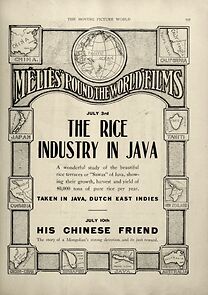|
A most complete study of the greatest crop growing industry of the island of Java. The immense rice fields are of two kinds; the “tegal,” or dry field, and the “sawash,” or wet field, laid out in terraces of different levels for irrigation purposes. After plowing and sowing the terraces are flooded for a period of eight or ten days. At the end of a month or six weeks the rice spikes, having grown crowded, are taken from the limited space in which they are confined and replanted in the “sawash” further apart to allow tall, strong growth. At the end of five or six months the terraces are in fall growth, and the whole village turns out to gather the harvest. The rice spikes tied in bundles are then packed and shipped by wagon to the mills, where the primitive method of treading by huge buffaloes is still in vogue. The rice is husked by means of a mortar and hammer, operated by boys. Then it is winnowed; allowed to fall a distance in the air, during which the husks are blown from the rice and pure rice is obtained. This rice is packed and shipped to Chelon to be stored, as very little rice is ever exported from Java. The island yields tons of rice a year, consumed entirely by the natives. Making rice liquor, an intoxicant, is another interesting feature of the picture. |
||
| Ratings: | IMDB: No rating yet | |
| Released: | July 3, 1913 | |
| Genres: | Documentary Short | |
| Countries: | United States | |
| Companies: | G. Méliès | |



Fenn : Series got cancelled after the second season (which ends as a total downer) so, if you don...